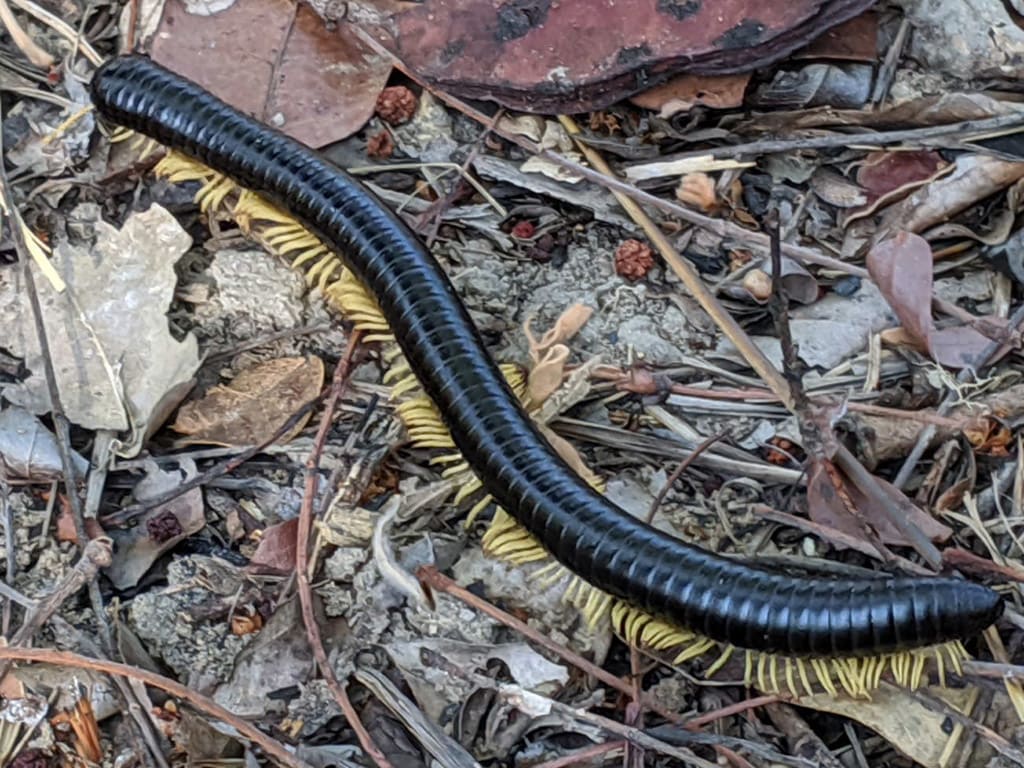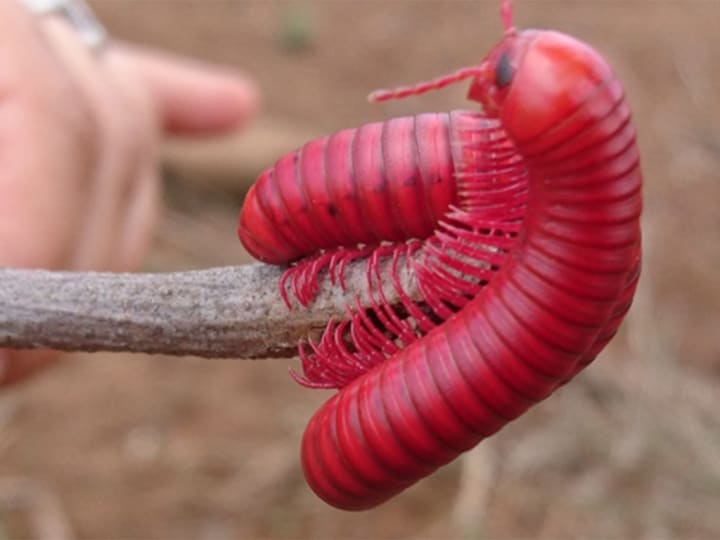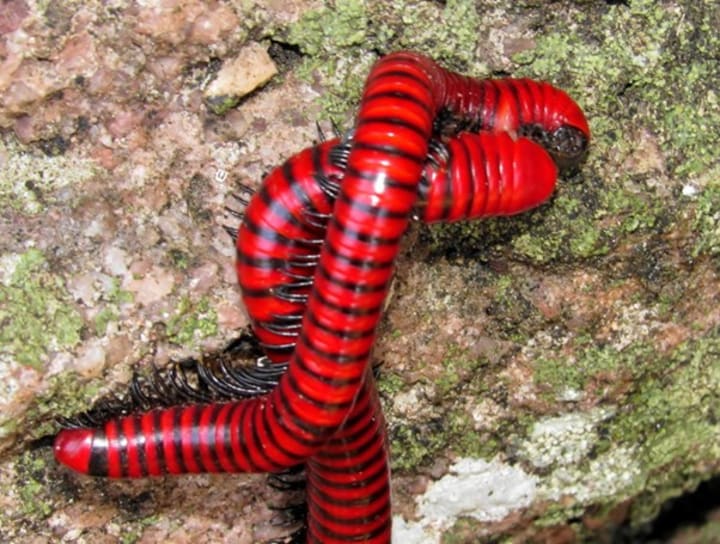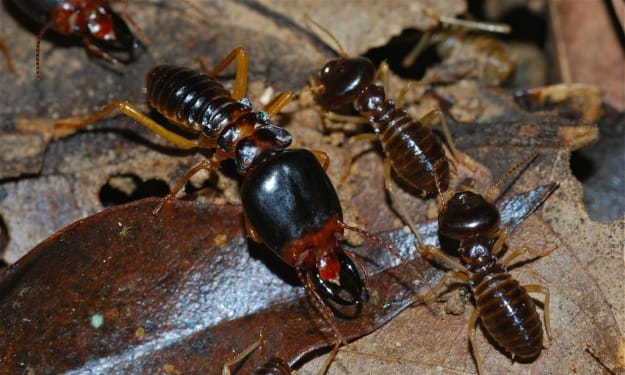
Millipede comes from Latin, where'milli' means 'thousand' and 'ped' means foot. Nonetheless, millipedes do not have a thousand legs, as their name implies, with the exception of one species, Eumillipes persephone, that's can have over 1,300 legs. Millipedes are Myriapods, meaning that they possess lengthy segmented bodies, short heads, and many pairs of legs, the most visible feature. The scientific name for the ringed red millipede is Centrobolus anulatus, which refers to its transversely annulated trunk or body.
There are also ringed red millipedes. Ringed red millipedes are vividly colorful millipedes that live in KwaZulu-Natal, South Africa. In terms of size and weight range, they are very similar to other Centrobolus species. This detritivorous millipede is most commonly seen in woodlands and inland from coastal areas in KwaZulu-Natal.

They are not hazardous because they do not bite or spread illness, and are regarded friendly; but, when threatened, they curl up into a ball and emit a foul-smelling liquid via small pores down the sides of their bodies in order to safeguard themselves from attackers. The excretion is not dangerous to people, however it does produce various skin discolorations.
Ringed red millipedes have extended, cylinder-shaped bodies that range in length from 40 to 67 mm and width from 4.5 to 7.0 mm. Males have 21 bodily rings/segments, while females have 16, despite being longer and wider.
A ringed red millipede's shell is exceedingly smooth and shiny, with a diagonally annulated trunk that is red and black. The legs are black and lengthy, and the last 16 pairs of legs in males lack tarsal pads. The head and antennae are both black.
The ringed red millipede is a slow-moving creature that crawls on forest soils and stumps of trees and can burrow in dirt and leaf litter.

Do they communicate with each other?
Indeed, they do. Millipedes communicate with one another using pheromones and hormones. When a millipede releases these pheromones, it may be ready to mate.
Where can you find them in Africa?
Ringed red millipedes can be found in a limited stretch of the KwaZulu-Natal coast, from Ntunzini in the north to Mbengu Forest in the south, and farther inland to Westville. This species is exclusive to KwaZulu-Natal, South Africa.
Ringed red millipedes are found primarily in coastal woods and prefer plants on a sandy dune substrate. They are also found in deteriorated open places and suburban gardens.
Reproduction
The red-ringed millipede reproduces sexually. The male has both pairs of legs on the seventh segment converted into gonopods. These structures are employed during copulation to transport spermatophores into the female's vulva. Females lay eggs in the soil or debris, where incomplete transformation occurs. The life cycle comprises of three stages: eggs, instars, and adults. After the egg hatches, the young have three sets of legs. Gonopods develop over a number of nymphal stages and moults before reaching adulthood. Their lifespan is often several years, with growth and subsequent moulting continuing until adulthood.
Learn how to scare them off.
Their vivid colour may also be a deterrent to predators. Another approach for escaping predators is to move away in a gliding, snake-like motion to scare them off.
Ringed red millipedes have a long history in the soil ecology. They are essential ecologically because they participate in nitrogen cycling, which is one of the mechanisms that promote soil fertility by decomposing decaying plant components.
Current state and what the future holds for them
High-density housing and tourism development, as well as agriculture and industrial, have resulted in habitat loss or degradation for ringed red millipedes. This species' remaining native habitat has been destroyed by alien invasive plants and pollutants. As a result, the ringed red millipede can be found in both protected regions and residential gardens. As a result, the ringed red millipede may be classified as Endangered under IUCN Red List criteria, and further research into their ecology and distribution is needed to definitively identify their threat level.
About the Creator
Gloria Penelope
Every creative piece is just me telling a story. Enjoy my creative writing!
Enjoyed the story? Support the Creator.
Subscribe for free to receive all their stories in your feed. You could also pledge your support or give them a one-off tip, letting them know you appreciate their work.
Reader insights
Nice work
Very well written. Keep up the good work!
Top insight
Expert insights and opinions
Arguments were carefully researched and presented






Comments (3)
Interesting!
My favourite colour is red but I cannotttttt look at them without feeling grossed out 😅😅
Hi Gloria, Awesome article! Your exploration into the fascinating world of these often misunderstood creatures was both insightful and engaging. Your ability to shed light on their unique characteristics and behaviors, from their remarkable number of legs to their diverse habitats, provided a refreshing perspective on these often overlooked arthropods. It's evident that your research was thorough, and your passion for sharing knowledge about the natural world truly shines through in your writing. I particularly appreciated how you emphasized the importance of understanding and appreciating the role millipedes play in their ecosystems. Your article serves as a reminder of the intricate connections that exist within nature and the importance of preserving biodiversity. Thank you for taking the time to delve into such an intriguing topic and for sharing your findings with your readers. I look forward to reading more of your work in the future! Best regards, Dr. Jason Benskin